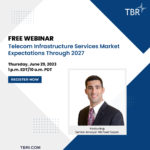Accenture and SAP Amplify the Value of the Ecosystem Through the Lenses of Compressed Transformation
Accenture hosted more than 140 clients, plus SAP executives, Accenture professionals and industry analysts, for its 2023 Accenture SAP Leadership Council. Unlike most industry gatherings, Accenture’s event, which included presentations, breakout sessions and networking opportunities, was described as a “council,” reflecting the company’s consistent emphasis on sharing client experiences and using the forum as an ongoing opportunity to seek advice and counsel from peers. TBR met individually with a range of Accenture and SAP clients and at length with Accenture executives, with the theme of the conference, “Time Is Now” coming through clearly and setting the pace for what to expect next from the collaboration between Accenture and SAP.
TBR perspective
Compounding the emphasis on the services and technology capabilities of Accenture (NYSE: ACN) and SAP (NYSE: SAP) at the Accenture SAP Leadership Council was a parade of client presentations that reinforced the ecosystem theme in large part through its ecosystem’s diversity, with clients representing the high-tech, manufacturing, pharmaceutical, telecom and utilities industries, among others. The organizational roles of the client speakers were equally diverse, with appearances by CIOs, finance officers, project management executives and digital transformation leads.
Similar to previous council attendances, TBR was struck by two consistent presentation trends. First, the casual discussions were frank; even on the main stage, the assessments of Accenture’s and SAP’s capabilities sometimes felt like an after-action review, rather than a typical feel-good IT story. Second, the SAP-centered discussions were not about the future but about the immediate present. Clients were already amid SAP journeys, seeing the benefits and seeking the next opportunities to shift workloads. Those two elements — the openness and the shared convictions around SAP — made the event more collaborative rather than a marketing forum for Accenture.
Exclusive market intelligence invites, Q&A invitations and data visualizations
Subscribe today!
Compressed transformation requires trust, standards and clean digital core
Council presentations made clear that the Accenture and SAP executives, along with their clients, recognized the opportunity, but also the workload complexity, associated with migrating to cloud. Decades of custom code development are now haunting vendors and clients, compelling them to reframe their thinking around the best approach moving forward, which to most would emphasize building standardized frameworks and solutions that can help accelerate time to market.
Given the downturn in the market economy that many buyers are facing, such a strategy would certainly be appealing and create opportunities for Accenture beyond its typical roster of large enterprise clients. Having coined this strategy as “compressed transformation,” Accenture understands differentiation is less about customizing a process and more about the value that will come from how employees use the process. Industry specialization will come into play, and the use of process mining tools, including SAP Signavio and others, will be a key enabler helping Accenture identify where to spend the most time.
Pursuing compressed transformation with Accenture can help buyers in two ways. First, it allows CIOs to identify priority areas of the business for transformation. Second, it can help them incorporate Accenture-delivered compressed transformation, using SAP technologies, allowing them to realize gains faster and add more value. Changing Accenture’s and SAP’s mindset on how to sell compressed transformation will also be key, especially as the companies’ decadeslong relationship has been built on trust and rooted in custom code development, coinnovation, codevelopment of code. and joint go-to-market efforts targeting large enterprises. Developing a clean digital core within existing buyers’ IT architectures presents a strong starting point for standardizing processes, but this is easier said than done, given the ocean of bad data that exists within current processes and makes it even harder to get a cohesive version of enterprise data.
The SAP Business Transformation Platform (BTP) — paired with Accenture’s approach to total enterprise reinvention, which integrates the power of Accenture’s businesses, including Accenture Strategy and Consulting; R&D capabilities; Accenture Technology, Delivery and Innovation centers; and Industry Networks — is vital to developing a clean digital core, especially as the two partners strive to drive value faster using accelerators wrapped in behavioral approaches to work more effectively.
In the near term, Accenture must carefully message its value proposition around the clean digital core to avoid jeopardizing relationships with its broader network of alliance partners, especially with buyers that are less convinced of the value of process standardization.
Accenture understands it cannot standardize all processes, especially for such complex environments like SAP, but the competition for mainstream migration services compels the company to think strategically about how to capture and deliver the most value for client engagements. Project management cost reduction and accelerated time to ROI provide fundamental incentives for buyers to consider embarking on the compressed transformation journey, leaving Accenture to address change management backed by consistent service quality to ensure success. According to TBR’s 4Q22 SAP Cloud report:
“SAP continues to report successful cross-sell synergies between flagship SaaS offerings and its expanded platform and tooling portfolio. Specifically, in 4Q22 80% of RISE with SAP customers also deployed elements of the Business Technology Platform (BTP), while the percentage of customers leveraging two or more SAP offerings increased to more than 30%. To strengthen its cross-selling approach and expand client average revenue per user (ARPU), SAP has increasingly sought to build emerging workloads, whether pertaining to Industry 4.0 or the more nascent sustainability space, around core systems such as S/4HANA. This portfolio tactic will help reduce sales hurdles for immature offerings where customer awareness and education are lacking, specifically those related to sustainability, by adding capabilities for business operations that customers have already enabled using SAP systems. …
“SAP is increasingly relying on ecosystem partners — infrastructure providers and services, consulting and technology specialists — to bolster portfolio development and workload implementation efforts. In support of this, SAP announced the new Partner Competency Framework during the quarter, which places partners into three tiers based on their skills, expertise and experience stacked against the framework’s competency and specialization requirements. Likewise, the program organizes partners around core solution competencies, such as ERP, CRM and human capital management (HCM), allowing customers to more quickly identify top partners based on their project needs.
“From a services standpoint, the new construct will help SAP identify leading implementation partners by solution area to recommend appropriate partners and convert an increasing cloud backlog, which reached $12.3 billion, growing 13.6% year-to-year in 4Q22.”
Using a customer-zero approach to promote the success of a large transformation program is not a new framework for Accenture, and the company’s IT migration to a single SAP instance enabled by RISE with SAP provides both a use case for standardization and migration as well as the necessary change management at scale.
Accenture’s ongoing investment in SAP resources, most recently through the acquisition of SKS Group, which added roughly 500 professionals to Accenture Technology’s roster across Germany, Austria and Switzerland to support clients within financial services using SAP S/4HANA solutions, demonstrates Accenture’s commitment to its relationship with SAP as Accenture strives to elevate the notion that adopting SAP solutions is less about addressing technology pain points and more about business implications and client outcomes.
Developing clean digital core and adopting composable IT architecture help set the stage for next wave of opportunities enabled by GenAI and delivered through the metaverse
While client and partner discussions throughout the council were largely rooted in today’s problems, Accenture took advantage of the opportunity to stretch participants’ thinking to consider the possibilities enabled by generative AI (GenAI) and the metaverse for the future. Accenture recognizes that both technologies are far from scaling adoption without building the appropriate use cases but also, importantly, without the support of the company’s technology partners.
The latter implication is even more true when it comes to the metaverse, which continues to face mainstream criticism. Accenture’s focus on building metaverse use cases for industrial clients backed by partner support in both messaging and portfolio development presents low-hanging fruit that can help Accenture capture opportunities from the converging OT and IT markets.
TBR sees a strong parallel between Accenture’s metaverse strategy and the company’s approach to building out sustainability use cases and portfolio offerings. Accenture started with thought leadership and research on the topic of sustainability while also getting key technology partners like SAP to buy in by colaunching sustainability-ready solutions and go-to-market efforts.
On the other hand, GenAI is now top of mind for Accenture, SAP and their clients. While largely going through the motions of the typical hype cycle, all parties understand the value of the technology will only come from a strong technology foundation and business-oriented discussions. Developing a clean digital core through composable IT architecture is a must-have, and the next wave of collaboration between Accenture and SAP can help provide the backbone for the adoption of these new technologies.
Conclusion
The Accenture and SAP partnership is strong. While each party must be careful about messaging related to the partnership so as not to disrupt the rest of their respective ecosystem partners, they understand each other’s strengths and value the joint opportunities that can be pursued. Going after established and new markets requires trust and an aligned, top-down vision with consistency in messaging, portfolio offerings and, increasingly importantly, team support being the keys to success, especially as the tight labor market continues to pressure vendors’ value proposition.
A dose of humility also helps, especially as Accenture and SAP are often seen as trendsetters in their respective markets, with clients appreciating the self-awareness and the willingness for targeted collaboration, backed by standardized processes and a focus on change management.
TBR publishes quarterly and semiannual analysis on both Accenture and SAP as part of our individual vendor coverage, as well as our benchmarks and market landscapes across IT services, cloud and digital research areas.




 Technology Business Research, Inc.
Technology Business Research, Inc.